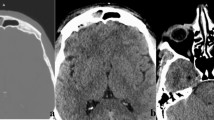Abstract
We report the evaluation of an automated method for quantification of brain tissue damage, caused by a severe traumatic brain injury, using mean diffusivity computed from MR diffusion images. Our automatic results obtained on realistic phantoms and real patient images 10 days post-event provided by nine different centers were coherent with four expert manually identified lesions. For realistic phantoms automated method scores were equal to 0.77, 0.77 and 0.83 for Dice, Precision and Sensibility respectively compared to 0.78, 0.72 and 0.86 for the experts. The inter correlation class (ICC) was 0.79. For 7/9 real cases 0.57, 0.50 and 0.70 were respectively obtained for automated method compared to 0.60, 0.52 and 0.78 for experts with ICC = 0.71. Additionally, we detail the quality control module used to pool data from various image provider centers. This study clearly demonstrates the validity of the proposed automated method to eventually compute in a multi-centre project, the lesional load following brain trauma based on MD changes.
Access this chapter
Tax calculation will be finalised at checkout
Purchases are for personal use only
Similar content being viewed by others
References
Cunningham, A.S., Salvador, R., Coles, J.P., et al.: Physiological thresholds for irreversible tissue damage in contusional regions following traumatic brain injury. Brain 128(Pt 8), 1931–1942 (2005)
Davenport, N.D., Lim, K.O., Armstrong, M.T., Sponheim, S.R.: Diffuse and spatially variable white matter disruptions are associated with blast-related mild traumatic brain injury. Neuroimage 59(3), 2017–2024 (2012)
Doyle, S., Forbes, F., Dojat, M.: P-locus, a complete suite for brain scan segmentation. In: 9h IEEE International Symposium on Biomedical Imaging (ISBI) (2012)
Dubuisson, M., Jain, A.: A modified hausdorff distance for object-matching. In: 12th International Conference on Pattern Recognition (IPAR), pp. 566–568 (1994)
Fiez, J.A., Damasio, H., Grabowski, T.J.: Lesion segmentation and manual warping to a reference brain: intra- and interobserver reliability. Hum. Brain Mapp. 9(4), 192–211 (2000)
Galanaud, D., Perlbarg, V., Gupta, R., et al.: Assessment of white matter injury and outcome in severe brain trauma: a prospective multicenter cohort. Anesthesiology 117(6), 1300–1310 (2012)
Irimia, A., Chambers, M.C., Alger, J.R., et al.: Comparison of acute and chronic traumatic brain injury using semi-automatic multimodal segmentation of MR volumes. J. Neurotrauma 28(11), 2287–2306 (2011)
Kim, N., Branch, C.A., Kim, M., Lipton, M.L.: Whole brain approaches for identification of microstructural abnormalities in individual patients: comparison of techniques applied to mild traumatic brain injury. PLoS One 8(3), e59382 (2013)
Maggia, C., Doyle, S., Forbes, F., Heck, O., Troprès, I., Berthet, C., Teyssier, Y., Velly, L., Payen, J.-F., Dojat, M.: Assessment of tissue injury in severe brain trauma. In: Crimi, A., Menze, B., Maier, O., Reyes, M., Handels, H. (eds.) BrainLes 2015. LNCS, vol. 9556, pp. 57–68. Springer, Cham (2016). https://doi.org/10.1007/978-3-319-30858-6_6
Maier, O., Schroder, C., Forkert, N.D., Martinetz, T., Handels, H.: Classifiers for ischemic stroke lesion segmentation: a comparison study. PLoS One 10(12), e0145118 (2015)
Manjon, J.V., Coupe, P., Concha, L., Buades, A., Collins, D.L., Robles, M.: Diffusion weighted image denoising using overcomplete local PCA. PLoS One 8(9), e73021 (2013)
Narayana, P.A., Yu, X., Hasan, K.M., et al.: Multi-modal mri of mild traumatic brain injury. Neuroimage Clin. 7, 87–97 (2015)
Pasco, A., Ter Minassian, A., Chapon, C., et al.: Dynamics of cerebral edema and the apparent diffusion coefficient of water changes in patients with severe traumatic brain injury. A prospective MRI study. Eur. Radiol. 16(7), 1501–1508 (2006)
Tagliaferri, F., Compagnone, C., Korsic, M., et al.: A systematic review of brain injury epidemiology in Europe. Acta Neurochir. 148(3), 255–268 (2006). discussion 268
Thornhill, S., Teasdale, G.M., Murray, G.D., et al.: Disability in young people and adults one year after head injury: prospective cohort study. BMJ 320(7250), 1631–1635 (2000)
Warfield, S.K., Zou, K.H., Wells, W.M.: Simultaneous truth and performance level estimation (staple): an algorithm for the validation of image segmentation. IEEE Trans. Med. Imaging 23(7), 903–921 (2004)
Watts, R., Thomas, A., Filippi, C.G., Nickerson, J.P., Freeman, K.: Potholes and molehills: bias in the diagnostic performance of diffusion-tensor imaging in concussion. Radiology 272(1), 217–223 (2014)
Acknowledgments
Grenoble MRI facility IRMaGe was partly funded by the French program Investissement d’avenir run by the Agence Nationale pour la Recherche; grant Infrastructure d’avenir en Biologie Santé - ANR-11-INBS-0006. Research funded by French ministry of research and education under the Projet Hospitalier de Recherche Clinique grant OXY-TC to JFP.
Author information
Authors and Affiliations
Corresponding author
Editor information
Editors and Affiliations
Rights and permissions
Copyright information
© 2018 Springer International Publishing AG, part of Springer Nature
About this paper
Cite this paper
Maggia, C. et al. (2018). Traumatic Brain Lesion Quantification Based on Mean Diffusivity Changes. In: Crimi, A., Bakas, S., Kuijf, H., Menze, B., Reyes, M. (eds) Brainlesion: Glioma, Multiple Sclerosis, Stroke and Traumatic Brain Injuries. BrainLes 2017. Lecture Notes in Computer Science(), vol 10670. Springer, Cham. https://doi.org/10.1007/978-3-319-75238-9_8
Download citation
DOI: https://doi.org/10.1007/978-3-319-75238-9_8
Published:
Publisher Name: Springer, Cham
Print ISBN: 978-3-319-75237-2
Online ISBN: 978-3-319-75238-9
eBook Packages: Computer ScienceComputer Science (R0)




